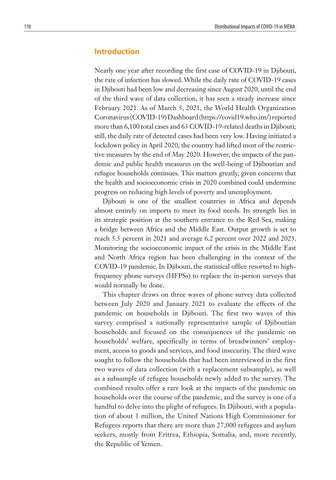118
Distributional Impacts of COVID-19 in MENA
Introduction Nearly one year after recording the first case of COVID-19 in Djibouti, the rate of infection has slowed. While the daily rate of COVID-19 cases in Djibouti had been low and decreasing since August 2020, until the end of the third wave of data collection, it has seen a steady increase since February 2021. As of March 5, 2021, the World Health Organization Coronavirus (COVID-19) Dashboard (https://covid19.who.int/) reported more than 6,100 total cases and 63 COVID-19-related deaths in Djibouti; still, the daily rate of detected cases had been very low. Having initiated a lockdown policy in April 2020, the country had lifted most of the restrictive measures by the end of May 2020. However, the impacts of the pandemic and public health measures on the well-being of Djiboutian and refugee households continues. This matters greatly, given concerns that the health and socioeconomic crisis in 2020 combined could undermine progress on reducing high levels of poverty and unemployment. Djibouti is one of the smallest countries in Africa and depends almost entirely on imports to meet its food needs. Its strength lies in its strategic position at the southern entrance to the Red Sea, making a bridge between Africa and the Middle East. Output growth is set to reach 5.5 percent in 2021 and average 6.2 percent over 2022 and 2023. Monitoring the socioeconomic impact of the crisis in the Middle East and North Africa region has been challenging in the context of the COVID-19 pandemic. In Djibouti, the statistical office resorted to highfrequency phone surveys (HFPSs) to replace the in-person surveys that would normally be done. This chapter draws on three waves of phone survey data collected between July 2020 and January 2021 to evaluate the effects of the pandemic on households in Djibouti. The first two waves of this survey comprised a nationally representative sample of Djiboutian households and focused on the consequences of the pandemic on households’ welfare, specifically in terms of breadwinners’ employment, access to goods and services, and food insecurity. The third wave sought to follow the households that had been interviewed in the first two waves of data collection (with a replacement subsample), as well as a subsample of refugee households newly added to the survey. The combined results offer a rare look at the impacts of the pandemic on households over the course of the pandemic, and the survey is one of a handful to delve into the plight of refugees. In Djibouti, with a population of about 1 million, the United Nations High Commissioner for Refugees reports that there are more than 27,000 refugees and asylum seekers, mostly from Eritrea, Ethiopia, Somalia, and, more recently, the Republic of Yemen.

